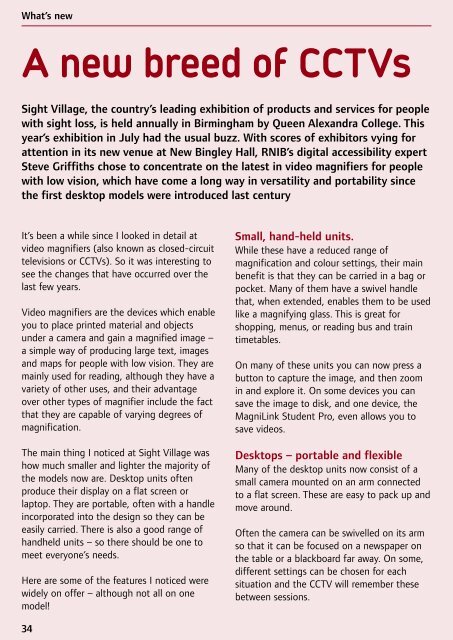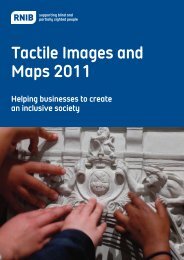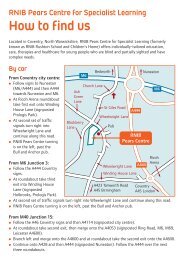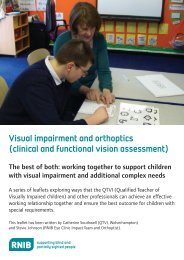Reflections on sight loss - RNIB
Reflections on sight loss - RNIB
Reflections on sight loss - RNIB
You also want an ePaper? Increase the reach of your titles
YUMPU automatically turns print PDFs into web optimized ePapers that Google loves.
What’s new<br />
A new breed of CCTVs<br />
Sight Village, the country’s leading exhibiti<strong>on</strong> of products and services for people<br />
with <strong>sight</strong> <strong>loss</strong>, is held annually in Birmingham by Queen Alexandra College. This<br />
year’s exhibiti<strong>on</strong> in July had the usual buzz. With scores of exhibitors vying for<br />
attenti<strong>on</strong> in its new venue at New Bingley Hall, <strong>RNIB</strong>’s digital accessibility expert<br />
Steve Griffiths chose to c<strong>on</strong>centrate <strong>on</strong> the latest in video magnifiers for people<br />
with low visi<strong>on</strong>, which have come a l<strong>on</strong>g way in versatility and portability since<br />
the first desktop models were introduced last century<br />
It’s been a while since I looked in detail at<br />
video magnifiers (also known as closed-circuit<br />
televisi<strong>on</strong>s or CCTVs). So it was interesting to<br />
see the changes that have occurred over the<br />
last few years.<br />
Video magnifiers are the devices which enable<br />
you to place printed material and objects<br />
under a camera and gain a magnified image –<br />
a simple way of producing large text, images<br />
and maps for people with low visi<strong>on</strong>. They are<br />
mainly used for reading, although they have a<br />
variety of other uses, and their advantage<br />
over other types of magnifier include the fact<br />
that they are capable of varying degrees of<br />
magnificati<strong>on</strong>.<br />
The main thing I noticed at Sight Village was<br />
how much smaller and lighter the majority of<br />
the models now are. Desktop units often<br />
produce their display <strong>on</strong> a flat screen or<br />
laptop. They are portable, often with a handle<br />
incorporated into the design so they can be<br />
easily carried. There is also a good range of<br />
handheld units – so there should be <strong>on</strong>e to<br />
meet every<strong>on</strong>e’s needs.<br />
Here are some of the features I noticed were<br />
widely <strong>on</strong> offer – although not all <strong>on</strong> <strong>on</strong>e<br />
model!<br />
Small, hand-held units.<br />
While these have a reduced range of<br />
magnificati<strong>on</strong> and colour settings, their main<br />
benefit is that they can be carried in a bag or<br />
pocket. Many of them have a swivel handle<br />
that, when extended, enables them to be used<br />
like a magnifying glass. This is great for<br />
shopping, menus, or reading bus and train<br />
timetables.<br />
On many of these units you can now press a<br />
butt<strong>on</strong> to capture the image, and then zoom<br />
in and explore it. On some devices you can<br />
save the image to disk, and <strong>on</strong>e device, the<br />
MagniLink Student Pro, even allows you to<br />
save videos.<br />
Desktops – portable and flexible<br />
Many of the desktop units now c<strong>on</strong>sist of a<br />
small camera mounted <strong>on</strong> an arm c<strong>on</strong>nected<br />
to a flat screen. These are easy to pack up and<br />
move around.<br />
Often the camera can be swivelled <strong>on</strong> its arm<br />
so that it can be focused <strong>on</strong> a newspaper <strong>on</strong><br />
the table or a blackboard far away. On some,<br />
different settings can be chosen for each<br />
situati<strong>on</strong> and the CCTV will remember these<br />
between sessi<strong>on</strong>s.<br />
34

















